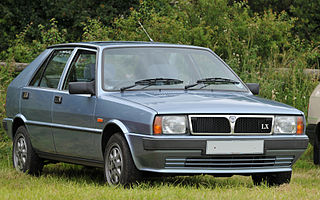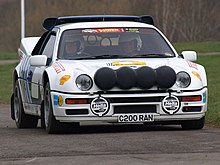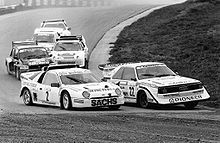
Cosworth is a British automotive engineering company founded in London in 1958, specialising in high-performance internal combustion engines, powertrain, and electronics for automobile racing (motorsport) and mainstream automotive industries. Cosworth is based in Northampton, England, with facilities in Cottenham, England, Silverstone, England, and Indianapolis, IN, US.

The Lancia Delta is a small family car produced by Italian automobile manufacturer Lancia in three generations. The first generation (1979-1994) debuted at the 1979 Frankfurt Motor Show, the second generation (1993-1999) debuted at the 1993 Geneva Motor Show, and the third generation (2008-2014) debuted at 2008 Geneva Motor Show.

The Peugeot 205 is a supermini (B-segment) car produced by the French manufacturer Peugeot from 1983 to 1999.

A four-wheel drive, also called 4×4 or 4WD, is a two-axled vehicle drivetrain capable of providing torque to all of its wheels simultaneously. It may be full-time or on-demand, and is typically linked via a transfer case providing an additional output drive shaft and, in many instances, additional gear ranges.
A World Rally Car is a racing automobile built to the specific regulations set by the Fédération Internationale de l'Automobile (FIA) and designed for competition in the World Rally Championship (WRC). The cars were introduced in 1997 as a replacement for Group A regulations used in the manufacturers' championship, and were replaced by Group Rally1 in 2022.

Front-wheel drive (FWD) is a form of engine and transmission layout used in motor vehicles, in which the engine drives the front wheels only. Most modern front-wheel-drive vehicles feature a transverse engine, rather than the conventional longitudinal engine arrangement generally found in rear-wheel-drive and four-wheel-drive vehicles.

The Lancia Stratos HF, known as Lancia Stratos, is a rear mid-engined sports car designed for rallying, made by Italian car manufacturer Lancia. It was a highly successful rally car, winning the World Rally Championship in 1974, 1975 and 1976; and race car winning 1974 Targa Florio, five times the Tour de France Automobile and three editions of Giro d'Italia automobilistico.

In automotive design, an RMR, or rear mid-engine, rear-wheel-drive layout is one in which the rear wheels are driven by an engine placed with its center of gravity in front of the rear axle, and thus right behind the passenger compartment. Nowadays more frequently called 'RMR', to acknowledge that certain sporty or performance focused front-engined cars are also "mid-engined", by having the main engine mass behind the front axle, RMR layout cars were previously just called MR, or mid-engine, rear-wheel-drive layout), because the nuance between distinctly front-engined vs. front mid-engined cars often remained undiscussed.

The Audi Quattro is a road and rally car, produced by the German automobile manufacturer Audi, part of the Volkswagen Group. It was first shown at the 1980 Geneva Motor Show on 3 March. Production continued through 1991.

Group B was a set of regulations for grand touring (GT) vehicles used in sports car racing and rallying introduced in 1982 by the Fédération Internationale de l'Automobile (FIA). Although permitted to enter a GT class of the World Sportscar Championship alongside the more popular racing prototypes of Group C, Group B are commonly associated with the international rallying scene during 1982 to 1986 in popular culture, when they were the highest class used across rallying, including the World Rally Championship, regional and national championships.

The Renault 5 Turbo or R5 Turbo is a sport hatchback automobile launched by the French manufacturer Renault at the Brussels Motor Show in January 1980. The car was primarily designed for rallying, but was also sold in a street version.

The Jaguar XJ220 is a two-seat sports car produced by British luxury car manufacturer Jaguar from 1992 until 1994, in collaboration with the specialist automotive and race engineering company Tom Walkinshaw Racing. The XJ220 recorded a top speed of 212.3 mph (341.7 km/h) during testing by Jaguar at the Nardo test track in Italy. This made it the fastest production car from 1992 to 1993. According to Jaguar, an XJ220 prototype managed a Nürburgring lap time of 7:46.36 in 1991 which was faster than any production car lap time before it.

The Lancia Fulvia is a car produced by Lancia between 1963 and 1976. Named after Via Fulvia, the Roman road leading from Tortona to Turin, it was introduced at the Geneva Motor Show in 1963 and manufactured in three variants: Berlina 4-door saloon, 2-door Coupé, and Sport, an alternative fastback coupé designed and built by Zagato on the Coupé floorpan.

The Lancia Delta S4 is a Group B rally car manufactured by the Italian car company Lancia. The Delta S4 competed in the World Rally Championship in 1985 and 1986, until Group B class was disbanded and the cars were eventually banned from competition completely by European sanctioning body FIA. The car replaced, and was an evolution of the 037. The S4 took full advantage of the Group B regulations, and featured a midship-mounted engine and all-wheel drive for superior traction on loose surfaces.

The Lancia Rally was a mid-engine sports car and rally car built by Lancia in the early 1980s to compete in the FIA Group B World Rally Championship. Driven by Markku Alén, Attilio Bettega, and Walter Röhrl, the car won Lancia the manufacturers' world championship in the 1983 season. It was the last rear-wheel drive car to win the WRC.

The Alfa Romeo Alfetta is a front-engine, five-passenger sedan and fastback coupé manufactured and marketed by Alfa Romeo from 1972 to 1987 with a production total over 400,000.

The Ferrari GTO is an exotic homologation of the Ferrari 308 GTB produced from 1984 until 1987 in Ferrari's Maranello factory, designated GT for Gran Turismo and O for Omologata.

The Mitsubishi Galant VR-4 was the range-topping version of Mitsubishi Motors' Galant model, available in the sixth (1987–93), seventh (1993–96) and eighth (1996–2002) generations of the vehicle. Originally introduced to comply with the new Group A regulations of the World Rally Championship, it was soon superseded as Mitsubishi's competition vehicle by the Lancer Evolution, and subsequently developed into a high-performance showcase of the company's technology.

The Ford Escort RS Cosworth is a homologation special of the fifth generation European Ford Escort. It was designed to qualify as a Group A car for the World Rally Championship in which it competed between 1993 and 1998. It was available as a road car from 1992 until 1996. The powertrain was only fitted to this version of the Escort, a longitudinally mounted Cosworth YBT, a highly tunable turbocharged 2.0 L (1,993 cc) with a bore x stroke of 90.8 mm × 77 mm Inline-four engine which had an output of 227 PS in standard trim. Tuning companies have achieved power outputs in excess of 1,000 bhp.

The Ford Sierra RS Cosworth is a high-performance version of the Ford Sierra that was built by Ford Europe from 1986 to 1992. It was the result of a Ford Motorsport project with the purpose of producing an outright winner for Group A racing in Europe.




























